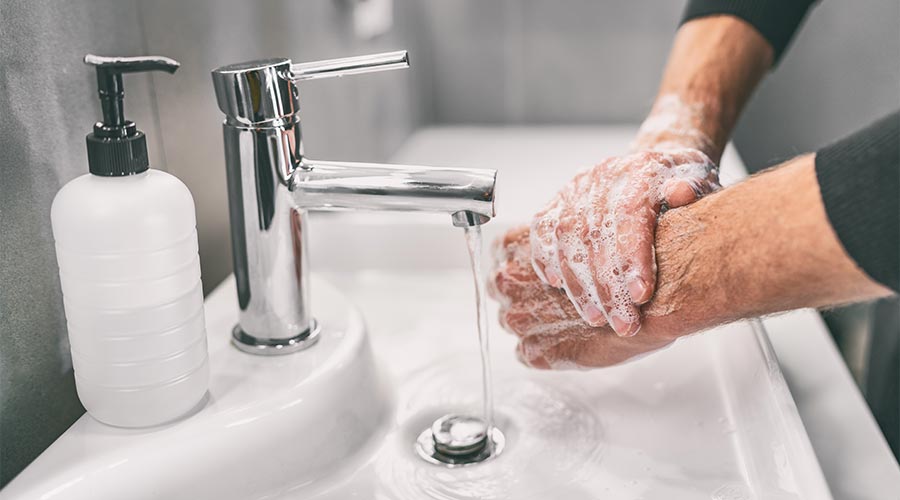
According to a study by Dr. Charles Gerba, professor of microbiology and infection control at the University of Arizona, handwashing practices before the pandemic left a lot to be desired. Results showed that of the 70 percent of people who washed their hands, only half of them used soap, and the average time spent washing hands was only 11 seconds.
“Only one in five people come out of a restroom having adequately washed their hands,” noted a surprised Dr. Gerba.
Fast-forward to the COVID-19 outbreak, and experts say that hand hygiene habits began to show signs of improvement. According to a 2020 Canadian study by Dial, 90 percent of people were washing their hands for the recommended 20 seconds — close to double the number of people properly washing their hands pre-pandemic.
While it’s been several years since the peak of the pandemic, recent handwashing studies continue to indicate a lasting improvement of habits overall. Bradley Corporation’s 2024 Healthy Handwashing Survey indicated that 89 percent of respondents washed their hands after using restrooms in public facilities. Additionally, nearly three-quarters of the same respondents (74 percent) indicated that they wash their hands more frequently or thoroughly in response to seasonal virus outbreaks.
Indeed, the consensus is that the pandemic renewed public interest in proper hand hygiene habits, and many facilities responded accordingly by upping the number of on-site hand-sanitizing stations.
“While hand hygiene studies are hard to parse depending on what was studied and by whom, one thing seems to be true: The use of hand sanitizer went up from 2019 (pre-pandemic year) to 2020 to 2022 (the post-pandemic years), but this was largely due to fear, panic and the desire to do something,” notes Allen Rathey, president, Healthy House Institute, Nampa, Idaho.
At the University of Arizona, hand sanitizer dispensers were placed at restroom exits and classroom entrances post-pandemic, prompting Gerba to conduct a study to determine if the expense was worth it. Spoiler alert: it was.
“Handwashing was really designed for bacteria, like shigella and salmonella, but we were wondering about the viruses,” Gerba explains. “The norovirus only takes one to 10 to infect, whereas bacteria take hundreds to thousands to make you ill.”
By conducting a quantitative microbial risk assessment, Gerba demonstrated that post-restroom use of automatic hand-sanitizer dispensers reduces the probability of viral infections by up to 99.75 percent. Unfortunately, handwashing alone is not enough to kill viruses.
The Case for Suds
Despite Gerba’s findings, the industry still advocates proper handwashing as the first line of defense against the spread of infection.
“The best advice your mother ever gave you was to wash your hands,” notes Darrel Hicks, industry consultant and infection prevention expert based in St. Louis. “Just because COVID-19 isn’t transferred via surfaces doesn’t mean there aren’t a lot of other bugs in the restroom and on every surface you touch.”
No doubt, handwashing methods are as important as frequency, but this is where people continue to fall short even after the pandemic. The majority still do not wash their hands for long enough, says Hicks, and most of them apply sanitizer to their palms only, neglecting their fingertips and in-between their fingers.
According to Rathey, COVID-19 did the industry a favor in that it drove awareness of the need for proper hand hygiene. The availability of hand sanitizer dispensers increased — as did their usage — but handwashing is still being shortchanged. And in many instances, hand sanitizer is being used as a replacement for washing with soap and water.
“When you’re in a rush, handwashing gets cut, and it’s a problem — especially in the healthcare industry,” he says. “Alcohol-based sanitizers can become a bit of a crutch. But it’s better to have a crutch than to fall down.”
Reading the Signs
To promote hand hygiene compliance, experts believe that the industry needs to work to affect behavioral changes. As Rathey notes, there are three elements needed to establish good habits: cue, routine and reward. A cue can take the form of signage in a restroom or other areas of a facility — but he suggests facilities keep it simple.
The Centers for Disease Control and Prevention (CDC) offers a wide range of printable posters on its website to help raise awareness of the importance of handwashing in public areas and how to do it correctly. Hicks is a fan of the CDC sign that imparts a pithy message reminding people to wash their hands after using the toilet: “One trillion germs can live in one gram of poop (that’s the weight of a paper clip!)”.
“It gives an effective visual, but it’s not shaming people,” he says. “It’s educating them about why it’s important: Studies show that when you flush the toilet, airborne particles are ejected six feet into the air and carried in air currents around the room. So, everything you touch has a fecal veneer on it.”
No doubt, developing good hand hygiene habits early on is easier than changing bad ones.
“The importance of handwashing seems to already be ingrained in school children, so hopefully there’s a generation coming along that will be better at it,” remarks Hicks.
Healthy Schools, Healthy People is an initiative between the CDC and the American Cleaning Institute (ACI) that provides schoolchildren nationwide with tools to reinforce regular handwashing practices. The organization’s website includes links not only to posters and handouts, but to storybooks, music and other activities that encourage healthy handwashing habits.
Overlooked Areas for Soap and Sanitizer Dispensers

 The Down and Dirty on Cleaning in Virus Season
The Down and Dirty on Cleaning in Virus Season How Surfactant Use is Expanding in Commercial Cleaning
How Surfactant Use is Expanding in Commercial Cleaning Clean Buildings Conference
Clean Buildings Conference
